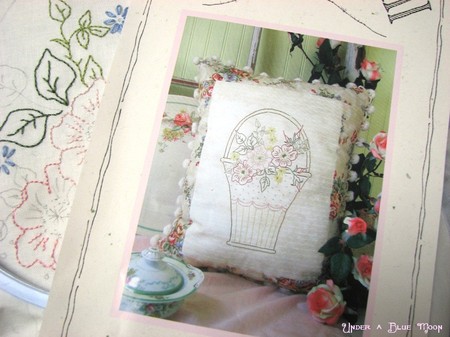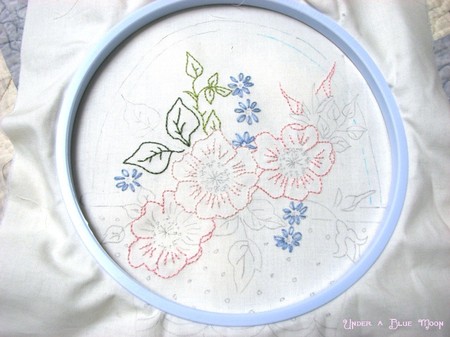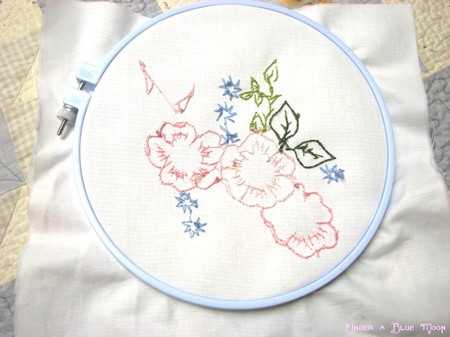I am making gentle progress on my embroidered pillow project. The best part of embroidering, in my opinion, is that you can pick it up and just spend a couple of minutes on it and then put it back down again. Unless you have some sort of self imposed deadline you really don’t have to commit big chunks of time to the project. There isn’t a lot of setting up that needs to be done or hard concentration needed.
Plus you can hop around on the design – if you get tired of green leaves you can move on to yellow French knots.
The pattern I am using is by Crab-apple Hill and is called Journal Rose. I took some liberties with the pattern and shortened the basket because I wanted to make a square pillow. Their pillow also has a pompom fringe and I am going to do a pleated one in a contrasting fabric instead.
This pattern has a LOT of French knots. I love French knots but every new project I start that has French knots involved requires a long look back at the instructions. I *think* I know how to do them – I’ve done lots of them and I confidently start out but my knot just disappears into a teeny stitch. No knot at all. I think it has something to do with being left handed and trying to do it right handed. Thank goodness for Janet at Primrose Design and her French knot tutorial. She can probably tell when I’m starting a new project because her stats on that particular blog entry go way up.
I find that I prefer traceable patterns to iron on ones. I just tape the pattern and my fabric to the living room window and trace away. It’s quite soothing, actually. I bought a great pen whose ink disappears when you get it wet but I find it dries out super quickly. Like I only get one tracing out of it.
Half the time I just use a No. 2 pencil and trace lightly. When I’m done embroidering I spray the piece with Zout and then hose it with my sink spray attachment.
Now for the backside – Yikes!
I’m getting better about weaving the end of the floss into the other stitches but I haven’t mastered doing the same to the beginning of the floss so there are little knots here and there.
A while back, when I was working on another project, a lovely reader sent me some very lightweight fusible interfacing that I use on the back of the fabric to help hide the rouge stitches. I love that stuff and I’m hoarding it. Using up every last little scrap.
One thing I’ve noticed is that I used the same floss colors over and over again. I’m like Picasso only I’m in my DMC #152 period. I think the next project will be done in very pale colors.



Very pretty. I love the Crabapple Hill patterns and have done quite a number of them. Please show us your pillow when you’re done!
And…re the lightweight interfacing – I’ve used that some, too, and the extra layer seems to give a pretty, finished effect as well as hiding threads. Another thing you can do is simply use a layer of muslin or other lightweight fabric underneath the stitching fabric. I’ve done that several times with good results – and I didn’t baste it together or anything – the hoop holds it together and once the first bit of embroidery is done, it’s not going anywhere.
Very pretty – and I love her patterns and also have several of them. I use a very light weight batting behind my stitcheries. It softens the stitches and certainly hides any tails of threads. My last stitchery that I traced I used a Micron Pigma pen in .005 and I love it. The stitchery is done all single ply black floss so I used a black pigma pen and it worked great. Lots of options out there to use.
I’m having a give away on my blog with a stitchery kit from Liberty Homestead and it has flowers and a basket also.
Hugs – Karen
Your stitchery is so pretty, and your work is wonderful. I also like a light weight batting behind…the stiches seem to lay down much nicer for me. Love your blog.
I think you have a very nice backside!
So glad you like the interfacing, it is my favorite for using for my embroidery projects.It works. I think it was a Crabapple Pattern , one of the first ones, that suggested using a lightweight interfacing and I’ve never looked back. Great tip. Love the Crabapple patterns, I am bit of a Meg Hawkey groupie. Lovely work, by the way.
Your embroidery is lovely, and the backside looks pretty good to me! I agree on the usage of the lightweight interfacing. It does help the stitches lay down as well as make sure they never come out. That’s always a bonus.
The great thing about embroidering for pillows is that no one will ever see the back side. Working neatly is a good habit but even I slack off when doing pillows!
You’ve perfectly articulated one of my favorite things about embroidery—the fact that you can work on it in very small doses. I rarely sit for more than half an hour, but those half hours add up quickly and the project is done before you know it. And I hop around within the design all the time, too.
Glad the French knot tutorial helped (and thanks for the link). I was worried about how my directions would translate for left-handed embroiderers.